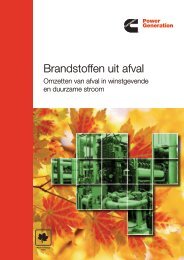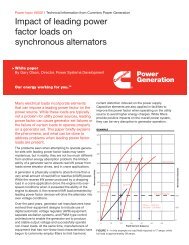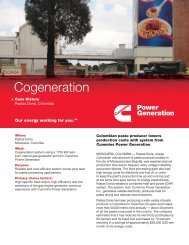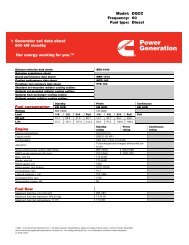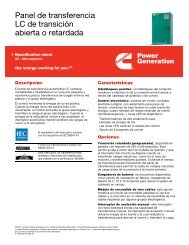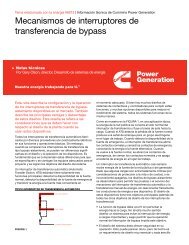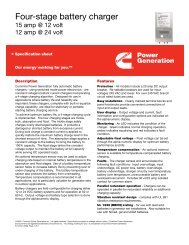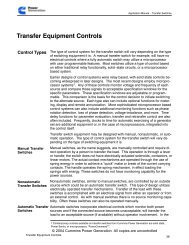appendix
appendix
appendix
You also want an ePaper? Increase the reach of your titles
YUMPU automatically turns print PDFs into web optimized ePapers that Google loves.
APPENDIX A<br />
Application Manual – Liquid Cooled Generator Sets<br />
hand, since VFDs ramp the load on, the starting requirements will be reduced compared<br />
to a motor started across the line. Select PWM if the VFD is of the pulse width modulated<br />
type. PWM type VFDs require less oversizing than non–PWM types.<br />
Motor starting requirements can be reduced by applying some type of reduced voltage or<br />
solid state starter. Application of these devices can result in smaller generator set<br />
recommendations. However, caution must be used when applying any of these starting<br />
methods. First of all, motor torque is a function of the applied voltage and all of these<br />
methods result in lower voltage during starting. These starting methods should only be<br />
applied to low inertia motor loads unless it can be determined the motor will produce<br />
adequate accelerating torque during starting. Additionally, these starting methods can<br />
produce very high inrush currents when they transition from start to run if the transition<br />
occurs prior to the motor reaching very near operating speed, resulting in starting<br />
requirements approaching an across the line start. GenSize assumes the motor reaches<br />
near rated speed before this transition, ignoring these potential inrush conditions. If the<br />
motor does not reach near rated speed prior to transition, excessive voltage and<br />
frequency dips can occur when applying these starters to generator sets. If unsure how<br />
your starter and load will react, use across–the–line starting.<br />
For across–the–line motor starting, select low inertia load if you know the load requires<br />
low starting torque at low speeds. This will reduce the starting kW requirements for the<br />
generator set and can result in a smaller set. Low inertia loads are typically centrifugal<br />
fans and pumps. If unsure, use high inertia (leave low inertia unselected).<br />
RkW If HP entered: RkW = (HP x 0.746) ÷ Running Efficiency<br />
If kW entered: RKW = kW ÷ Running Efficiency<br />
If Ramps entered: 1∅ RkW = (Ramps x voltage x RPF x Efficiency) ÷ 1000<br />
3∅ RkW = (Ramps x voltage x RPF x Efficiency x 1.73)<br />
÷ 1000<br />
RkVA RkVA = RkW ÷ RPF<br />
RPF Running power factor as entered or default from database<br />
SkW High Inertia SkW = SkVA x SPF<br />
Low Inertia SkW = SkVA x SPF x 0.6<br />
SkVA SkVA = HP x (LRkVA/HP) x SkVA factor, where LrkVA/HP is the average kVA/HP<br />
for the NEMA Code letter of the motor, and SkVA factor is 1.0 for full voltage<br />
starting, or from reduced voltage starting table (see Reduced Voltage Starting<br />
Method)<br />
SPF As entered, or default values from database by HP and starting method<br />
For loads that are designated to automatically cycle on and off:<br />
PkW PkW = SkW<br />
PkVA PkVA = SkVA<br />
AkW (non–VFD) AkW = RkW except solid–state starter where AkW = 2.0 x RkW<br />
unless a bypass contactor is used, then AkW = RkW<br />
AkW (VFD) Conventional AC Inverter: AkW = 2.0 x RkW<br />
Pulse Width Modulated: AkW = 1.4 x RkWDC Drive: AkW = 2.0 x RkW<br />
Ramps 1∅ Ramps = (HP x 746) ÷ (voltage x Efficiency x RPF)<br />
3∅ Ramps = (HP x 746) ÷ (1.73 x voltage x Efficiency x RPF)<br />
Fire Pump Load Calculations<br />
GenSize will size the generator limiting the peak voltage dip to 15% when starting the fire<br />
pump,with all other non–surge loads running. This is to meet North American fire code<br />
requirements. The generator set does not have to be sized to provide the locked rotor<br />
kVA of the fire pump motor indefinitely. That would result in an oversized generator set,<br />
which could experience maintenance and reliability issues from being under–utilized.<br />
Rev. Jan 2011<br />
A–11




